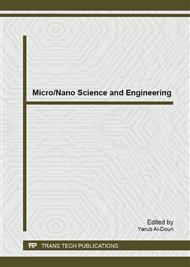p.3
p.8
p.13
p.18
p.23
p.28
p.33
p.38
Effects of Process Variables on Size of Chitosan-Alginate Capsules through Extrusion-Dripping Method
Abstract:
The objective of this study was to investigate the effects of process variables on size of chitosan-alginate capsules produced through extrusion-dripping method. Chitosan-calcium chloride solution was extruded into sodium alginate to form chitosan-alginate capsules which have a defined inner core and membrane. The results showed that sodium alginate concentration, chitosan concentration, chitosan to calcium chloride concentration ratio, needle diameter, gelation time have significant effect on the diameter and membrane thickness of chitosan-alginate capsules. Under the tested condition, chitosan-alginate capsules with diameter in a range of 3.4 mm to 4.5 mm were produced. The membrane thickness of the capsules increased when the curing time increased from 5 min to 60 min. As the concentration of sodium alginate (0.3-0.9 %w/v) and chitosan (0.4-1.0 %w/v) increased, the diameter of the chitosan-alginate capsules increased. The diameter of chitosan-alginate capsules increased with decreasing the chitosan to calcium chloride concentration ratio (1:0.5-1:1.5).
Info:
Periodical:
Pages:
8-12
Citation:
Online since:
April 2014
Price:
Сopyright:
© 2014 Trans Tech Publications Ltd. All Rights Reserved
Share:
Citation:


